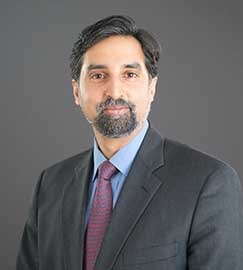Jul 27
2021
How COVID-19 Changed Medical Research

By Vikram Savkar, vice president and general manager of the medical segment, Wolters Kluwer’s Health Learning, Research and Practice business
The pandemic has shone a critical light on every aspect of the medical ecosystem, revealing which systems were adequate and which were not – in a way that only a global crisis could have done. There has been widespread discussion since the start of the pandemic, concerning changes to public health systems, medical supply chains, medical education, telehealth infrastructure, and more. Less often discussed, but just as disrupted by the pandemic, is medical research communication.
Encompassing peer-reviewed scholarly journals, books, websites, conferences, point-of-care devices, and more, the medical publishing ecosystem is a critical connection point, ensuring that clinicians and healthcare leaders around the world have access to current information about new and emerging treatment approaches.
Looking Beyond the Journal
The pandemic generated needs that went well beyond the comfort zone of this traditional set of tools. Even in the fastest scenario, a journal article once submitted takes months to reach readers and is preceded by additional months of research. This ultimately means that a hypothesis that a clinical researcher is exploring will take half a year or more to progress from concept to readership. In the early months of the pandemic, front-line clinicians could not wait six months to consider therapies for their COVID-19 patients. They needed to act immediately.
In the absence of peer-reviewed research in the early months of the pandemic, clinicians turned to preprint servers, case reports, and even social networks – through which they were able to receive real-time advice from fellow clinicians in other hospitals and other countries on “what was working and what was not.”
Now that a year has passed, there is a substantial body of peer-reviewed, well-established work on COVID-19 in traditional journals, and we can expect to see the global community’s therapeutic and public health approach returning to traditional research-based foundations for the remaining years of pandemic response. But the need that the onset of the pandemic revealed – for much faster and less formal channels of information sharing to sit alongside the more traditional channels – cannot be “put back in the bottle”. The need must be addressed with new systems, new technologies, and new approaches – so that the global community can be better prepared for future crises.
Case Study for Rapid Information Sharing: GIDEON Database
One particular database serves as an excellent example of how the pandemic illuminated limitations in our traditional approach to medical information: GIDEON. Founded by Stephen Berger and Uri Blackman in 1990, the GIDEON database has grown to be one of the most comprehensive sources for up-to-date information on infectious diseases around the world.
In January 2020, GIDEON tracked 360 infectious diseases. In February 2020, based on early reports from China and other countries, GIDEON added the 361st: COVID-19. Over subsequent months, the team worked day-and-night to source data globally and share it in a single comprehensive database and search environment. This data was a critical part of how researchers and clinicians in more than 120 countries drew conclusions from the best evidence available at the time and formulated public health responses and clinical pathways for the growing number of COVID-19 patients. From this perspective, the GIDEON database is a good example of how non-journal communication technologies that predated the pandemic were able to rise to the occasion.
From another perspective, however, the experience of the GIDEON team also highlights ways in which the global community continues to be unprepared to meet the needs of crisis situations. The COVID-19 data which GIDEON sourced from many differing countries around the world were deeply heterogeneous: different units and formats, different sample sizes, different metrics tracked, and so on. Combining this data into a single database that clinicians could look to as a reliable source of information required daily manual data normalization and harmonization by the GIDEON team, which in itself delays the reporting of results.
Addressing this inherent inefficiency will require agreement by hundreds of countries, each with their own ministries of health subject to their own local politics, to agree to a unified standard of data tracking and reporting that can be immediately leveraged by GIDEON and other technologies. Unfortunately, this level of data harmonization between countries could take years. The experience of GIDEON during the COVID-19 crisis will remain a salient example of how the medical world is (and is not) well situated to share critical information in the modern age.
Regardless of the challenges, though, the experience of the pandemic makes clear that the medical research information world must now adapt rapidly, whether through expanding access to preprint servers, coordinating globally on sharing data and code from research projects, or utilizing artificial intelligence to better probe emerging phenomena.